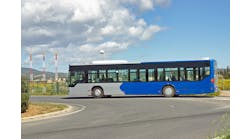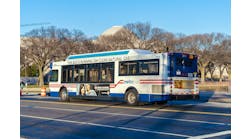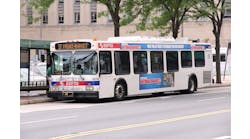After 10 years of planning, design and construction, Lane Transit District (LTD) opened one of the first full-function bus rapid transit (BRT) systems in the U.S. on Jan. 14, 2007. The system, branded “EmX,” consists of a 4-mile section of route linking the downtown area of Eugene, Ore., with downtown Springfield. By incorporating light-rail transit (LRT) design elements, including level boarding, wider stop spacing, signal priority and median stations, EmX will maintain consistent running times and operate more effectively and efficiently than traditional transit. In addition, it comes with a price tag that has many transit districts seriously thinking BRT might work in their community.
After 18 months of operation, the EmX service continues to grow, with ridership approximately doubling the route it replaced.
Rail tie
With the recent increase in fuel costs, demand for public transportation has increased. This has provided a dilemma for public transportation providers. While they are encouraged by the increased number of passengers, their systems are becoming overloaded, and the price of fuel is weighing heavily on their budget. Some larger cities have developed rail-based systems that are powered by electricity, which has partially shielded them from the recent fuel increase. However, smaller cities do not have the population base or the funding support to build LRT. While LRT is seen as an attractive transit solution because of its broad appeal to riders and its contribution to a city’s urban character, conventional bus services are perceived by many to be the mode of last resort. Given the lack of viable solutions, small- to medium-sized cities have struggled with the challenge of improving transit service in order to provide an alternative to the automobile.
While there are many forms of BRT, the most developed form mimics the service and operating characteristics of LRT. BRT was identified as an innovative, low-cost transit strategy that can meet the needs of the Eugene-Springfield metropolitan area as part of the Regional Transportation Plan update. The proposed BRT system is composed of high-frequency rapid transit service along major corridors, with smaller buses providing access from neighborhoods to the BRT lines, as well as nearby shopping and businesses. System features can include exclusive transit lanes, transit-signal-priority systems, barrier-free fare collection, real-time passenger information systems and limited stations with improved facilities. At a much lower per-mile cost than rail-based systems, BRT is seen as an appropriate and cost-effective solution for medium-sized cities and offers a similar appeal to its LRT counterpart.
EmX links two of LTD’s major hubs in downtown Eugene and downtown Springfield. Attempting to provide the greatest possible amount of exclusive right-of-way, approximately two-thirds of the EmX route uses exclusive lanes. LTD plans to add exclusive lanes as redevelopment occurs along a key section of roadway connecting the two communities.
A bustlin’ bus
LTD is a public transportation agency that operates 110 buses and provides other alternative transportation services in metropolitan Eugene-Springfield, as well as portions of rural Lane County. LTD currently provides approximately 11 million trips per year. LTD has a history of innovation and forward thinking, and EmX represents LTD’s newest strategy for innovative transit service.
In response to the community’s growth and the increasing demand for faster, more-convenient transit service, LTD began preliminary engineering work for the implementation of its EmX system in 1998. The EmX system is based on LRT principles, but rather than the required capital investment in trains and track, it utilizes buses in service that integrate key components of the existing automobile transportation infrastructure, such as roads and rights-of-way, intersections and traffic signals.
Therefore, EmX is more affordable, flexible and appropriate in scale for a medium-sized metropolitan area such as Eugene-Springfield. In addition, it has allowed for incremental construction and implementation, which were easily tailored to meet the specific transportation needs and opportunities within individual neighborhoods as well as along the transportation corridor.
The EmX service offers many advantages to regular bus service, including greater reliability, improved image, increased capacity and speed. The following service features have increased travel speed and service capacity and reduced passenger travel time on the EmX corridor:
- Exclusive transit lanes;
- Fewer stations than traditional transit service;
- Signal prioritization technology and queue jumps to reduce delays;
- Headway-driven schedule with increased service frequency;
- Easy access, low-floor, multiple-door buses;
- Rail-like vehicles; and
- New image and identity.
LTD’s application of BRT is a systems concept that addresses all elements of service. As a systems approach, the application of BRT in the Eugene-Springfield area is very different from the BRT systems that were adopted by several North American cities in the 1970s. These systems were focused primarily on exclusive rights-of-way with little, if any, attention given to other service elements.
Under these conditions
The 1996 update of the Regional Transportation Plan initiated planning for the EmX system. The conceptual planning took the approach of sketching out the desired future system at full build out, which consists of five direct cross-town routes and a single circumferential route. The initial corridor was selected through a public process from the routes in the conceptual plan. The first corridor selection was based on existing travel needs in the community and the desire to have a successful first corridor. This corridor links two of LTD’s major hubs in downtown Eugene and downtown Springfield.
A series of conditions were placed on project approval by congressional representatives and the LTD board. The purpose of these conditions was to ensure full community buy-in to the project as well as to ensure that the project’s success was due to attracting riders. These conditions impose zero impact to automobile travel times over the 20-year design period, minimal impact to adjacent properties and no relocation of businesses or residences. Approval to move ahead with the project also was contingent upon the approval of all jurisdictions in the project area. An additional complicating factor was a city of Eugene ordinance restricting tree removal in the right-of-way. This ordinance required that each tree more than 50 years old and of a specific size be subject to a city-wide vote before removal is permitted.
Several charettes (design workshops) involving elected officials, community members, design professionals and jurisdictional staff were held to develop the preliminary EmX designs for the corridor. Individual meetings with each property owner along the proposed corridor were held to discuss issues and project implications.
While BRT is unique in that it can be implemented incrementally, the community indicated a desire to incorporate the full range of BRT components to maximize the potential of this system and effectively compete with the automobile in terms of travel time.
Public input continued throughout the project. From early design charettes to the assistance of both cycling groups and individuals with disabilities, LTD has worked in partnership to create a system that enhances capacity along the corridor. People with disabilities assisted staff in the placement of vehicle doors and in testing the layout of wheelchair bays. A vehicle interior mock-up was constructed by LTD, providing a testing ground where designers could make specific decisions regarding the placement of a rear-facing wheelchair bay. Cyclists with bikes traveled inside articulated buses to provide feedback on where and how bicycles could best be accommodated inside the EmX vehicle. Employees, technical staff from local jurisdictions and stakeholder groups continue to participate in review and implementation processes.
Follow and lead
Because the Franklin EmX corridor is located in an existing buildup area with limited right-of-way and high levels of congestion, the design called for some unconventional solutions. Because of its similarities to LRT (the concept of BRT is to mimic LRT), the design of the first BRT systems has been based on traditional LRT principles. However, owing to the flexibility of BRT, it is possible to incorporate design elements that would not be possible in a rail-based system. These design elements could be utilized where design constraints restrict the adoption of the full technique.
These solutions included the use of transitways; single-lane, two-way BRT operations; and block-traffic signaling. These elements are summarized as follows:
Transitways
One of the key elements in the development of a BRT system is providing uninterrupted travel that allows transit vehicles to move freely and provides a fast, regular and reliable service.
However, it is often the case that communities like Eugene-Springfield realize the need for improvements to their transit system after urban corridors have already been built up and no additional right-of-way is available.
In an effort to identify with LRT as much as possible, the EmX system transitways are located in the median of the street in order to distinguish them from conventional bus services that operate curbside. To further accentuate the rail-like appearance, the transitways were designed as two separate running surfaces with grass planted in between. The grass reduces impervious surface area and improves the aesthetics of the facility. The transitways are separated from the general traffic by 6-in. curbs.
Where the transit facility runs adjacent to general traffic lanes without a barrier, the lanes have been constructed in concrete to clearly differentiate between the asphalt general traffic lanes and the concrete EmX lanes.
Single-Track, Two-Way Operations
Although most of the transitways will be dual tracks, there are sections of the corridor where, because of restricted right-of-way, EmX vehicles traveling in opposite directions will need to share the same transitway. This technique has been used extensively in rail-based systems, but has not been explored in bus systems. While two-way operation of the transitway increases the efficient use of the facility, the key concerns are operational efficiency and safety. From an operational point of view, possible delays to EmX vehicles must be minimized. This is accomplished by reducing the length of the single-lane sections and by providing frequent opportunities for vehicles to pass. The possibility of two EmX vehicles traveling in opposite directions in the same section of transitway must be eliminated. While initially there is a safety concern about the possibility of a head-on collision, this possibility is rare as drivers have “line of sight” on all sections of the corridor.
Block Signaling
Unlike traditional reversible lanes where the directions change infrequently (perhaps only once or twice a day), the single transitway requires the ability to safely and efficiently change the direction of flow on a cycle-by-cycle basis. The principle of railroad block signaling is used as a basis of control.
The control strategy for the single transitway is similar to control used in many light-rail operations. Entry points to single-track blocks are controlled by BRT signals that give only one bus the right-of-way to enter the block at any time. A block controller intercepts calls for bus priority. If there is not an active request for priority in the opposite direction, it transmits the priority request to the intersection for activation. Once a block controller has permitted entry into the block, it does not allow calls for opposite-direction buses until after the first bus has checked out of the last intersection in the block.
Eight EmX stations utilize raised platforms, display a distinctive shelter design and will greet customers with real-time passenger information (real-time passenger information will be implemented in fall 2008). Stations are located predominantly in the median of the street, reinforcing the rail-like nature of the service. Fare collection is currently planned to occur at the station rather than inside the vehicle.
Vehicles that were specially designed for the EmX service include multiple doors on both sides, larger passenger capacity and low floors. Utilizing a hybrid-electric power train, these vehicles are quieter, more energy efficient and better for the environment.
Bicycles are accommodated on board, and rear-facing wheelchair positions are provided to eliminate the need to secure wheelchairs. The service schedule is headway-driven, meaning that vehicles arrive at a frequency that eliminates the need for a timetable.
In addition to transit improvements, LTD has collaborated with the local jurisdictions in addressing a number of traffic safety and capacity issues, including the provision of enhanced bicycle and pedestrian connections.
Turning 20 in four months
The EmX has been and continues to be a great success. The system hit its projected 20-year ridership within four months of operation. A recent survey shows passenger satisfaction as very high.
LTD’s EmX system is now a fixture on the urban landscape in Eugene and Springfield, with passengers enjoying the simplicity and directness of the service. Although the EmX system employs some uncommon operating arrangements, the system has experienced fewer crashes than expected after 11/2 years in operation. A majority of the 12 crashes that have occurred resulted from illegal-side traffic maneuvers.
The final construction cost of the system (including six vehicles at $960,000 each) was $23.5 million, which approximates to about $6 million per mile.
The 4-mile Franklin corridor has provided an excellent opportunity to showcase how effectively BRT can work in small- to medium-sized communities. It is only the beginning of a system that will provide an enhanced transit experience for decades to come. The second EmX line, the Pioneer Parkway Extension, will begin to showcase the time-saving aspects of this new system. The implementation date will be in fall 2010.
The extension will provide service to a new $350 million regional medical facility and to one of the region’s fastest-growing business, hotel and retail centers.


